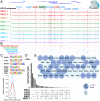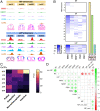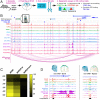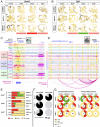Transcriptional network orchestrating regional patterning of cortical progenitors
- PMID: 34921112
- PMCID: PMC8713794
- DOI: 10.1073/pnas.2024795118
Transcriptional network orchestrating regional patterning of cortical progenitors
Abstract
We uncovered a transcription factor (TF) network that regulates cortical regional patterning in radial glial stem cells. Screening the expression of hundreds of TFs in the developing mouse cortex identified 38 TFs that are expressed in gradients in the ventricular zone (VZ). We tested whether their cortical expression was altered in mutant mice with known patterning defects (Emx2, Nr2f1, and Pax6), which enabled us to define a cortical regionalization TF network (CRTFN). To identify genomic programming underlying this network, we performed TF ChIP-seq and chromatin-looping conformation to identify enhancer-gene interactions. To map enhancers involved in regional patterning of cortical progenitors, we performed assays for epigenomic marks and DNA accessibility in VZ cells purified from wild-type and patterning mutant mice. This integrated approach has identified a CRTFN and VZ enhancers involved in cortical regional patterning in the mouse.
Keywords: cortical patterning; epigenetics; progenitor cells; transcription factors.
Copyright © 2021 the Author(s). Published by PNAS.
Conflict of interest statement
Competing interest statement: J.L.R. is a cofounder, stockholder, and currently on the scientific board of Neurona, a company studying the potential therapeutic use of interneuron transplantation.
Figures







Similar articles
-
Transcriptional regulation of enhancers active in protodomains of the developing cerebral cortex.Neuron. 2014 Jun 4;82(5):989-1003. doi: 10.1016/j.neuron.2014.04.014. Epub 2014 May 8. Neuron. 2014. PMID: 24814534 Free PMC article.
-
Potential target genes of EMX2 include Odz/Ten-M and other gene families with implications for cortical patterning.Mol Cell Neurosci. 2006 Oct;33(2):136-49. doi: 10.1016/j.mcn.2006.06.012. Epub 2006 Aug 17. Mol Cell Neurosci. 2006. PMID: 16919471
-
Expression of ventral telencephalon transcription factors ASCL1 and DLX2 in the early fetal human cerebral cortex.J Anat. 2019 Sep;235(3):555-568. doi: 10.1111/joa.12971. Epub 2019 Mar 12. J Anat. 2019. PMID: 30861584 Free PMC article.
-
Emx2: a gene responsible for cortical development, regionalization and area specification.Gene. 2002 May 29;291(1-2):1-9. doi: 10.1016/s0378-1119(02)00623-6. Gene. 2002. PMID: 12095673 Review.
-
Transcriptional and epigenetic mechanisms of early cortical development: An examination of how Pax6 coordinates cortical development.J Comp Neurol. 2016 Feb 15;524(3):609-29. doi: 10.1002/cne.23866. Epub 2015 Aug 25. J Comp Neurol. 2016. PMID: 26304102 Free PMC article. Review.
Cited by
-
A developmental gradient of COUP-TFI expression regulates the relative size of hippocampus dorsal and ventral subregions.PLoS Biol. 2025 Aug 25;23(8):e3003355. doi: 10.1371/journal.pbio.3003355. eCollection 2025 Aug. PLoS Biol. 2025. PMID: 40853986 Free PMC article.
-
Genetic Regulation of Vertebrate Forebrain Development by Homeobox Genes.Front Neurosci. 2022 Apr 25;16:843794. doi: 10.3389/fnins.2022.843794. eCollection 2022. Front Neurosci. 2022. PMID: 35546872 Free PMC article. Review.
-
Molecular signatures of cortical expansion in the human fetal brain.bioRxiv [Preprint]. 2024 Feb 13:2024.02.13.580198. doi: 10.1101/2024.02.13.580198. bioRxiv. 2024. Update in: Nat Commun. 2024 Nov 8;15(1):9685. doi: 10.1038/s41467-024-54034-2. PMID: 38405710 Free PMC article. Updated. Preprint.
-
Asynchronous excitatory neuron development in an isogenic cortical spheroid model of Down syndrome.Front Neurosci. 2022 Sep 7;16:932384. doi: 10.3389/fnins.2022.932384. eCollection 2022. Front Neurosci. 2022. PMID: 36161168 Free PMC article.
-
Profile of John L. R. Rubenstein.Proc Natl Acad Sci U S A. 2021 Dec 28;118(52):e2120493118. doi: 10.1073/pnas.2120493118. Proc Natl Acad Sci U S A. 2021. PMID: 34934007 Free PMC article. No abstract available.
References
Publication types
MeSH terms
Substances
Grants and funding
LinkOut - more resources
Full Text Sources
Molecular Biology Databases
Miscellaneous

